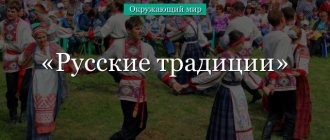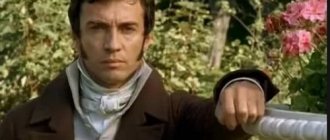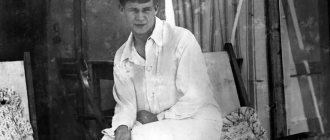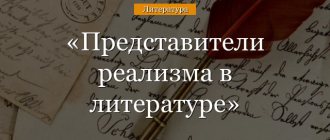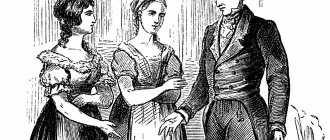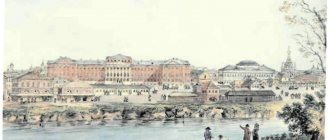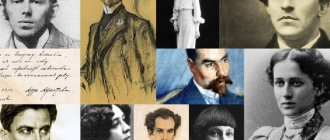Romanticism as a literary movement
Literature is an ever-changing, ever-evolving phenomenon.
Speaking about the changes that have occurred in Russian literature in different centuries, it is impossible to ignore the topic of successive literary trends. Definition 1
A literary movement is a set of ideological and aesthetic principles characteristic of the works of many authors of the same era.
There are a huge variety of literary trends. This includes classicism, realism, and sentimentalism. A separate chapter in the history of the development of literary movements is romanticism.
Definition 2
Romanticism (French romantisme) is a literary movement that considered the spiritual and creative life of the individual and his independence and freedom to be the highest values.
Are you an expert in this subject area? We invite you to become the author of the Directory Working Conditions
Romanticism first appeared in France during the era of the Great French Revolution (1789 - 1799) and the world industrial revolution. This trend dominated European and Russian literature at the end of the 18th - first half of the 19th centuries.
Romanticism was preceded by classicism and the Age of Enlightenment. Romanticism denied many of the values of these ideologies. For example, if classicism gave preference to reason (ration), then romanticism focused on feelings (emotion). Classicism spoke about civilization, romanticism about nature; For classicists, society and the state were important, for novelists - freedom, feelings and aspirations of the individual.
Vasily Zhukovsky: creativity
Most schoolchildren know who Zhukovsky is. Many people are familiar with Zhukovsky’s work as a romantic poet. He was glorified by ballads and romantic poems, but the theater awakened his first impulses to creativity.
As a young man, Vasily wrote the tragedy “Camillus, or Rome Liberated,” a melodrama based on the novel “Paul and Virginia.” Under the influence of the son of the director of the Moscow boarding school, Andrei Turgenev, Zhukovsky became interested in the German romantics and became interested in poetry, and his acquaintance with Karamzin, who became his mentor, opened the way to literature.
Photo: Wikipedia: UGC
Having studied the life and work of Zhukovsky, I will highlight several periods in the development of his writing talent:
For some time, Zhukovsky, whose creativity was more exciting than accounting calculations in the Salt Chamber, was looking for a way into literature. He began with translations that were highly valued by publishers: he translated novels by Kotzebue, Cervantes, and Chateaubriand. The young official took part in meetings of the literary society, but public service prevented him from realizing himself as a writer. Therefore, contrary to the advice of his mother and friends, Zhukovsky resigned and in 1802 moved to Moscow to engage in creativity.
He is interested in German elegiac poetry. Zhukovsky begins with translations, soon copies German romantics and looks for his own style in melancholic lyrics. The romantic search for one’s own style lasted from 1808 to 1812, which was embodied in the ballads “Lyudmila” and “Svetlana” - a rehash of Burger’s “Lenora”, “The Aeolian Harp”. Zhukovsky publishes translations and his own works in Vestnik Evropy, of which he became editor in 1808.
The war with Napoleon, personal dramas, a literary discussion between the “Conversation of Lovers of the Russian Word” society (led by Shishkov) and “Arzamas”, where Zhukovsky was secretary, were factors that influenced the development of his poetic talent.
Throughout the 1814–1820s. the poet Zhukovsky creates the ballads “Love Carousel”, “The Old Woman”, and the story in verse “The Twelve Sleeping Virgins”. Having entered the service of the imperial family in 1817, Zhukovsky discovered his talent as a court poet (“The Mysterious Visitor”, and “The Inexpressible”, and “To a Genius Who Flew By”, “The Color of the Testament”, and “Lalla Ruk”, etc.). ).
The public was delighted with his translations of the novel “Ondine” by Lamotte-Fouquet, the Indian and Iranian poems “Nal and Damayanti”, “Rustem and Zorab”.
Zhukovsky the writer completed his literary career with the poem “The Wandering Jew” and the elegy “The Swan of Tsarskoye Selo”. After the triumph of translating the Odyssey, the poet began translating the Iliad, but the project could not be completed.
Chivalry, heroism, tender love, longing for the ideal, passion for the fantastic - these are the themes to which the poet Vasily Andreevich Zhukovsky devoted himself. The writer’s biography is connected with the development of romanticism in Russian literature and the formation of verification norms of national poetry.
Romanticism in Russian literature of the 19th century
The development of Russian romanticism was influenced by two major historical events:
- Patriotic War of 1812;
- Decembrist uprising of 1825.
The leading minds of that time were disillusioned with the ideas of the Enlightenment and anticipated a radical change in the socio-political structure of Russia. They stood up for the creation of a fundamentally new society in which justice would prevail.
Finished works on a similar topic
Coursework Romanticism in Russian literature 490 ₽ Essay Romanticism in Russian literature 220 ₽ Examination Romanticism in Russian literature 230 ₽
Receive completed work or specialist advice on your educational project Find out the cost
Note 1
The main value of novelists is a person’s personality.
The works of the romantics do not reflect the real world as it is, but the whole universe of the main character’s feelings, experiences and internal conflicts. The hero cannot come to terms with the baseness and ordinariness of reality, does not obey its morality and law.
The poet V.A. is considered one of the founders of romanticism in Russia. Zhukovsky. His ballads, poems, elegies, messages and romances, filled with deep philosophical meaning and striving for a certain moral ideal, fully reflected romantic values.
Romantic works by V.A. Zhukovsky:
- "Undine";
- "Forest King";
- "Svetlana";
- "Rural Cemetery";
- "Slav".
Following Zhukovsky, N.V. turned to romanticism. Gogol and M.Yu. Lermontov. Their work belongs to a different stage in the life of the Russian Empire. In 1825, the Decembrist movement was defeated, which led to an ideological crisis in society. In romantic works, motifs of disappointment with real life and attempts to escape from it into an ideal world began to appear.
These ideas were especially clearly reflected in Lermontov’s society. The writer openly sympathized with the defeated Decembrists.
Note 2
Romanticism was characterized by an appeal to folklore and folk themes.
Romantic works by M.Yu. Lermontov:
- "Mtsyri";
- “Song about the merchant Kalashnikov”;
- "Ishmael Bey."
Romantic works were also written by A.S. Pushkin. As is known, he also sympathized with the Decembrists and largely shared their beliefs. Working at the beginning of the 19th century, during the heyday of romanticism, he could not have ignored this literary trend.
Romantic works by A.S. Pushkin:
- "Queen of Spades";
- "Eugene Onegin";
- "In the depths of Siberian ores..."
Novelists also include E.A. Baratynsky, K.F. Ryleev, V.K. Kuchelbecker and others.
Novelists often created ballads and dramas, and also asserted a new purpose for poetry - a space for expressing the highest aspirations and desires of man.
The main features of romanticism in literature, characteristics of a romantic hero
In order to understand whether a particular work belongs to romanticism, you need to know the main features of a romantic work.
The highest values for a romantic writer were:
At the center of a romantic work is a romantic hero . It has the following features:
Additionally, it must be said that romanticism is essentially subjective, which is why romantic works often have a confessional nature, and romantic writers identify themselves with their heroes.
K. Bryullov “The Last Day of Pompeii”
History of Russian Romanticism
“The history of romanticism in Russian literature”, “Nauka”, M. 1979, vol. I. “The emergence and establishment of romanticism in Russian literature (1790–1825).” Executive editor A. S. Kurilov, 312 pp.: vol. II. “Romanticism in Russian literature of the 20s and 30s of the 19th century. (1825-– 1840)". Executive editor S. E. Shatalov, 326 pp.
In recent years, a number of serious works have appeared devoted to the most important aspects of the theory and history of romanticism in domestic and world literature. In this regard, it is enough to name the collective work of the IRL “The Age of Romanticism”, the major monograph by Yu. Mann “The Poetics of Russian Romanticism”, the collection “Problems of Romanticism” edited by U. Vocht, the publication of Kazan and Kalinin Universities.
The main goal facing the authors of the collective work of IMLI on the fate of Russian romanticism was formulated already in the Introduction: “to objectively reveal the features of the historical existence of romanticism” on Russian soil, while merging together “two methodologies, two approaches; typological and concrete historical” (I, 10), that is, “to present Russian romanticism in a dual sense – as a historically logical link in world romanticism and at the same time as one of the most important parts of Russian literature” (I, 16).
This task is urgent, but very difficult. Russian romanticism is a complex, multi-component phenomenon, which includes the seemingly contrasting artistic worlds of Boratynsky, Tyutchev, Pushkin, Lermontov, and other figures of Russian literature. And the dignity of the work under review lies precisely in the fact that every significant phenomenon of Russian literature in the period from the 1790s to the 1840s is considered, on the one hand, in all its intrinsic value, and on the other, in its conjugation and interaction with previous ones and subsequent cultural phenomena.
Based on the premise: “Each national literature discovered romanticism when the socio-historical development of the corresponding peoples led them to this...” (I, 12-13), the authors convincingly prove that the emergence of romanticism in Russian literature was not caused by any or external influences. He is “a deeply unique, nationally distinctive phenomenon, generated by his own prerequisites of a socio-historical and literary order” (II, 3). This thesis, formulated at the beginning of the second volume, is revealed and argued throughout the study.
“The History of Romanticism...” shows how the emergence of new social and psychological relations, their gradual establishment in the public consciousness, before giving their aesthetic fruits, became noticeable at the level of everyday life, in everyday life: “Young nobles left their service in droves and went to their estates , experiencing the most sincere joy from the consciousness of his emancipation from any civil obligations...” “Over a number of decades in Russia, an essentially anti-Enlightenment conviction gradually took shape that a person’s right to personal life is above his duty to serve society” (I, 31, 33). Researchers carefully trace how the changing reality contributed, so to speak, to the growth of the value of the human personality. Writers—not yet romantics, but in their work research thought already “recognizes” distant signs of the future romantic worldview—introduce “personal” motives into their works, which is a serious innovation (Lomonosov), V. Fedorov convincingly shows that Karamzin’s work from the very beginning it outgrew the framework of sentimentalism (of which he is considered to be the largest representative).
Showing the organic necessity of the emergence of romanticism in Russian literature at the turn of the 18th–19th centuries, the authors of the collective work correctly resolve the question of the degree of influence of Western literature of that era on Russian writers: “...If romanticism for our writers of that time were, artistically, a completely new phenomenon , then all the “romantic beauties” ... had to inevitably remain beyond the threshold of their perception. These beauties “would not be recognized” by them as artistic phenomena that can... be creatively used in their own artistic practice” (I, 17–18).
A thorough analysis of that complex set of phenomena, which is usually designated by the term “pre-romanticism” and includes elements of classicism, sentimentalism, enlightenment, emerging romanticism, the beginnings of realism, leads researchers to a reasonable conclusion: “Romanticism of the late 18th – early 19th centuries. grew not out of sentimentalism as such, but out of... the general pre-romantic literary movement, where sentimentalism was one of the most noticeable ideologically and aesthetically shaped trends” (I, 30).
Seeing in the development of literature, first of all, progress in the depiction of the world and man, the authors of the work, however, do not follow this view one-sidedly. They refuse both the categorical opposition of classicism and romanticism to each other as “regressive” and “progressive” movements in the literature of the late 18th century, and generally the sharp division of these borderline phenomena.
The desire to present each link of literary development as part of an integral, living system is clearly manifested not only in general conclusions concerning the era of romanticism as a whole, but also in memorable literary portraits of figures of the romantic era. Thus, in the chapter dedicated to Tyutchev (E. Lebedev), the presence of uneradicated educational and sentimentalist views in the work of the young poet is rightly pointed out; As for his later love lyrics, in it Tyutchev “rises to a direct accusation of the immorality of society itself and in this respect becomes on a par with the greatest Russian realists, his younger contemporaries - Tolstoy and Dostoevsky” (II, 100). In the essay about Zhukovsky (S. Shatalov), the legend about the lack of independence of his poetic creativity, about the “borrowed” nature of his inspiration, is completely rejected. Listing the poet's works created by the end of the 1810s, the researcher about (I, 143).
However, in addition to analyzing the mutual influence of parts of a cultural whole, so to speak, vertically, in diachrony (the contact of romanticism with classicism, sentimentalism, enlightenment and realism), “The History of Romanticism...” also provides a study of the synchronic aspect of the existence of romanticism. It seems useful and promising to study not only the “peak” phenomena of Russian romanticism (Zhukovsky, young Pushkin, young Gogol, Lermontov), but also that broad cultural background that seems to nourish and prepare the emergence of any outstanding cultural phenomenon. Indicative in this sense are the chapters devoted to Benediktov and “fairytale”, “terrible” and “fantastic” stories, novels and stories (V. Troitsky); The existence of the “romantic-mystical” element in Lermontov’s work (E. Pulkhritudova) is interestingly interpreted. As a result, a dialectical picture of historical and literary development appears before the reader.
The wide range of phenomena covered, combined with the depth of analysis, allows the authors to take a new approach to many well-known phenomena of Russian literature and critically reconsider a number of established ideas. Thus, I. Usok and V. Troitsky reveal a certain commonality in the work of Zhukovsky and the Decembrist poets, who are usually sharply opposed to each other (I, 280–281). The prevailing opinion about the secondary place of poetry in Russian literature of the 30s of the 19th century is refuted with sufficient reasoning. E. Pulkhritudova’s approach to Lermontov’s poem “Borodino” as a romantic work is original, although not indisputable.
The chapters on the work of such romantic poets as Zhukovsky, Kozlov, Boratynsky, Tyutchev, without changing the strictly scientific tone of the entire work, appear as a fusion of a sketch of creativity, an essay and a miniature biography (where the life of the poet is revealed through his work) Emotionality, “empathy” for the object research helps the authors show the dynamics,
internal specificity of romantic art. Here are examples: “Freedom is the highest requirement of romantics. Personal freedom is a prerequisite for happiness and a manifestation of the natural state of man. And if freedom is unattainable in the social sense, then with all the greater tenacity the romantics defended it in spiritual life... In the situation depicted (we are talking about Zhukovsky’s ballad “Alina and Alsim” - E. S., K. S.) there is no freedom, there is violence, therefore, there is endless suffering, suffering! (I, 127). And further the author points out that “Zhukovsky personally experienced this order: “It’s different for you!” (I, 128). In the chapter on Tyutchev we read: Tyutchev “not only had a mind of phenomenal strength, responsiveness and vigilance, always aimed at the fundamental issues of existence... he also had the rare (and difficult) gift of experiencing history in the literal sense of the word as a fact of his personal biography” (II , 81–82).
The free manner of presentation is combined with rigor and analytical consistency. We mean the logical unity of thought, which, permeating the entire study, does not allow it to disintegrate into a series of essays, a series of literary medallions with portraits of writers of the romantic era inscribed in them.
The consistency of scientific thinking is visible, for example, in how the well-known thesis about the “two worlds” of romantic art is interpreted. It is widely and at the same time shown in detail how romantic consciousness not only reflects in artistic images the fragmentation, the fracture of bourgeois reality, the imaginary reality of the present, the reality of only spiritual life - the work also traces the heroic overcoming of this duality by romantic art. Let us show this using the example of the figures most vividly illuminated in “The History of Romanticism...” - Zhukovsky, Boratynsky, Tyutchev, Lermontov.
The essence of Zhukovsky’s lyrics (S. Shatalov) is defined as follows: “...The past, having been purified and enriched in thinking about it, will repeat itself in some other existence” (I, 129).
This idea is significant. Without any doubt, Zhukovsky’s hero is not active in the literal sense of the word, but the will, mind, and imagination of the hero create, and their activities are aimed at ennobling and improving reality. The ideal that Zhukovsky’s hero carries within himself “purifies and enriches” reality, justifies it in spite of itself.
The chapter on Boratynsky (E. Lebedev) begins as follows: “Boratynsky came to Russian romanticism with his own special theme - the theme of torn consciousness”
(II, 67). It would seem to be a continuation (albeit, perhaps, modified) of the same reasoning about the incompatibility of this world and the other world, reality and aspirations to the beyond. This, however, is not the case. Boratynsky, in his comparison of two worlds and in his understanding of their tragic incompatibility, goes much further than Zhukovsky. The line between two worlds is “a painful tragedy of a soul that dared to unite two realities” (I, 72). We are thus talking about deepening the tragedy of the romantic. The presence of Boratynsky's lyrical hero in reality is much more active and hotter than Zhukovsky's. Despite the constantly recurring motif of disappointment in Boratynsky’s poetry, reality is deeply experienced by the hero, and the pain from contact with it is intense and acute.
Dramatic contact with reality enriches Boratynsky's creative consciousness. The “dispute within romanticism” that arose in Boratynsky’s poetic world is significant. The poet - and this is proven in the work - seems to “overcome” romanticism (the reduced-romantic, pseudo-heroic image of the hussar in “Eda”). But the process of overcoming is not completed, not completed. “The romantic approach to the subject also affected the new artistic attitude to reality that was emerging in Boratynsky’s mind: the realistic picture of the relationships between the characters (we are talking about “Ed.” - E. S., K. S.) was enclosed by him in a romantically conventional frame” (II , 80).
In Tyutchev (E. Lebedev), the contradiction of participation and simultaneous non-participation “in the affairs of the world” becomes even deeper, more complex, and indirect. On the one hand, the poet strives to “minimize external connections with the human world” (I, 82). But along with this, he is characterized by a constant desire to resolve moral (that is, universally important) problems and tasks. The global, radical study of existence undertaken by the lyricist is a universally significant matter. The researcher writes about the “heart spasms” experienced by the poet on the path to understanding the whole, that is, about “the most dramatic stage of the development of the individual into a harmonious personality” (II, 103). But the individual seeks harmony not only for himself; harmonizing, it brings harmony to the big world and obtains it for humanity as a whole.
The romantic polarity, “binary” in Lermontov’s lyrics is interpreted and analyzed differently. In an essay dedicated to Lermontov (E. Pulkhritudova), we read the following: “Lermontov’s romanticism destroyed the boundaries between the literary “top” and “bottom”: it was democratic both in its content and in its historical and literary mission. The everyday received a grandiose metaphysical projection from Lermontov. The exceptional in Lermontov’s romanticism was coupled with the plural, the brilliant was a mystified version of the ordinary” (II, 273). Lermontov, the creator of grandiose images of “individualists,” always had images of reality, the everyday, the plural, within his very artistic consciousness. Next to the “individualist” Pechorin, Lermontov created the image of Maxim Maksimych, which meant so much for the development of Russian psychological prose; the proximity of these heroes is deeply justified; they seem to complement each other. E. Pulkhritudova comes to the following logical conclusion: “All the poets scolded the crowd,” including young Lermontov. In his matured poetry, rejection is replaced by analysis...” (II, 298).
Thus, the authors of “The History of Romanticism...” consistently destroy the myth about the fundamental exclusion of the romantic hero from reality, ultimately arriving at an important generalization: “The Hegelian thesis about the absolute alienation of romantic consciousness from objective reality is hardly applicable to Russian romanticism...” (II, 105 – 106).
In the same way, the authors of the work under review carefully and deeply traced the formation and development of such fundamental categories of the theory and practice of romanticism as historicism and nationality. Having predetermined in their time the emergence and flourishing of a new method, they contributed to the further replacement of romanticism with the method of realism. Even in the highest manifestations of romanticism, such as, for example, Pushkin’s “southern poems” (V. Korovin), researchers see the prerequisites for its future crisis. The same vigilance of the eye helps to identify, classify and evaluate everything new and valuable, which enriched Russian literature with romanticism. As a result, the thesis: “without romanticism the most significant achievements of realism would not have been possible” does not seem postulated, but organically follows from the entire course of the study.
Interesting and informative are the review analyzes of Russian romantic theory and criticism of each historical stage (A. Kurilov, V. Sakharov), in which the achievements of literary critical thought of that time are carefully examined and assessed from the standpoint of today. Rethinking some of the judgments of critics of the last century (including Belinsky), the authors of the work do not violate the basic principle of historicism: to value the figures of the past for what they gave, and not to reproach them for what they (according to the conditions of the time) did not give could.
Most of the shortcomings of “The History of Romanticism...”, like any serious work, artistic or scientific, are a continuation of its merits.
The desire of the authors to highlight in almost every romantic phenomenon or fact the beginnings of realism, those elements that will then, through modification, be included in realistic poetics, sometimes becomes intrusive.
Wanting to characterize in as much detail as possible the historical and national specifics of Russian romanticism, the authors often lose sight of the pan-European literary “background” (regionally, this applies, first of all, to French and German romanticism, and in genre terms, the prose of the romantics). Meanwhile, a thorough appeal to this material would help to highlight more clearly and clearly the uniqueness of Russian romanticism and, perhaps, more generally, of Russian literature as such. This should be done both in the analysis of the relationship between the romantic hero and reality, and in the analysis of such basic categories of romanticism as historicism and nationality. The observation of E. Pulkhritudova is absolutely correct: “...The severity of social issues is not an indispensable sign of realism. Especially in Russian literature of the 30s, where the most consistent and energetic protest against the existing order of things often manifested itself precisely in romantic works” (II, 283). Probably, this important feature of Russian romanticism, which manifested itself so clearly in the 30s, was prepared by the entire course of its previous development, and here is one of its main specific features? But this deserved a much more detailed conversation.
We have already said that the work combines a respectful approach to the achievements of literary critics and theorists of the past with a critical assessment of their positions and conclusions. But it is hardly, say, worth seeing in the types of romanticism named by the Russian critic V. Plaksin (“according to sources of inspiration”) (medieval, mystical, national-mythological) three main directions in the development of Russian and European romanticism of the late 18th – early 19th centuries (those Moreover, this is contradicted by most of the studies in the two-volume book).
By the way, in the question of differentiation of directions and currents of Russian romanticism in the work under review, there is generally some vagueness. On page 109 of the first volume it is said that in the first years after the Patriotic War of 1812, Russian romanticism was divided into two movements (for some reason an exact definition of the essence of which was not given). Here, of course, we are not talking about the division of romanticism in terms of the subject of depiction - the inner world of man and the “times of chivalry” - which is later said to be “two most important directions (cf. above: three. - E. S. ., K.S.) in the development of romantic poetry... characterized the first stages of the development of literary romanticism in Russia in the 19th century.” (I, 180). Just below it is said that in the “southern period” Pushkin carried out “a synthesis of the two most important currents of Russian romanticism – psychological and civil” (I, 187). Such inconsistency does not contribute to the correct orientation of the reader.
The statement made by the authors in the Introduction to the second volume is puzzling: “After the defeat of the Decembrists there followed... a significant and rapid change... in the artistic characteristics of those works that were perceived by readers and critics as romantic...” (II, 7). Since this thesis has not been discussed in sufficient detail, one may get the impression that such a “significant and rapid change” became possible due to the complete lack of development of the concept of romanticism in Russian criticism of those years and the absence of any criteria in the minds of readers. But this was not the case, which is confirmed by the entire course of previous research (in the first volume).
One can only regret that in “The History of Romanticism...”, where much attention is naturally paid to works that stand on the verge of two methods—romanticism and classicism, romanticism and realism—almost no attention is paid to “A Hero of Our Time,” in which, undoubtedly, , the influence of the worldview of romanticism is very strong (especially since at the beginning of the section dedicated to Lermontov, it is indicated that the question of the writer’s creative evolution, and in particular whether he remained a romantic until the end of his days, right up to “A Hero of Our Time”, still not resolved by literary criticism - II, 258). This omission is all the more regrettable because E. Pulkhritudeva convincingly refuted many misconceptions, in particular, about eclecticism and the lack of independence of Lermontov’s realism; she subtly noted that Lermontov’s path to realism “lay not so much through the quantitative accumulation of everyday realities as through the intensification of the author’s “subjectivity” generated by the romantic beginning of Lermontov’s creativity” (II, 291).
The noted shortcomings, as we see, are not fundamental.
In general, the collective work “The History of Romanticism in Russian Literature,” together with its predecessor, the three-volume “Development of Realism in Russian Literature,” also prepared by IMLI scientists, will become a milestone in Soviet academic literary criticism.
- Along the way, one can also regret that the section on Pushkin did not include an analysis of “small tragedies” and “The Queen of Spades.”[]
